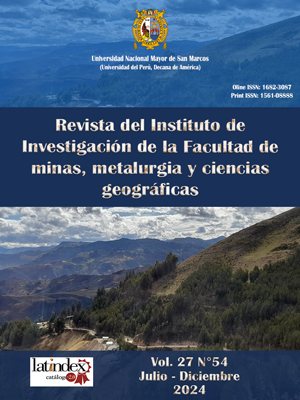Onset and cessation of the rainy season on the Lake Titicaca slope
DOI:
https://doi.org/10.15381/iigeo.v27i54.28628Keywords:
rainy season, Titicaca Lake, gridded database, trend analysis, seasonAbstract
This study investigates the spatial and temporal variation of the rainy season on the slopes of Lake Titicaca by analyzing rainfall series extracted from the gridded database PISCOp V2.1 and 18 meteorological stations within the study area. The onset and end of the wet season from 1981 to 2012 were evaluated using gridded data, which were then validated with recorded rainfall data and performance statistical indicators. This methodology allowed the determination of the onset and end of the rainy season for each hydrological year of the study period, and the calculation of metrics such as rainy days, wet season rainfall, and rainfall intensity. The resulting time series were subjected to trend analysis, revealing that, in general, they did not exhibit statistically significant trends. This conclusion was also supported by the trend analysis of the series derived from the gridded data. The results highlight the importance of using validated gridded data for studying climatic patterns and accurately assessing the temporal variability of rainfall.
References
Allaire, J. J. (2012). Obtenido de R-Project: https://www.r-project.org/
ANA. (2008). Delimitación y codificación de unidades hidrográficas del Perú: resumen ejecutivo
Autoridad Nacional del Agua (ANA). https://hdl.handle.net/20.500.12543/1880
Burn, D. H., Abdul Aziz, O. I., & Pietroniro, A. (2004). A Comparison of Trends in Hydrological Variables for Two Watersheds in the Mackenzie River Basin . Canadian Water Resources Journal / Revue Canadienne Des Ressources Hydriques, 29(4), 283–298. https://doi.org/10.4296/cwrj283
Chambi Echegaray, G., Herencia Félix, B. G., Cabrera Carranza, C. F., Malca Casavilca, N., Torres Guerra, J., Jesus Matos, H., Rendon Schneir, E., & Montero Chirito, J. C. (2023). La vulnerabilidad de las ciudades de Piura frente a las inundaciones producto del incremento de lluvias en episodios de El Niño. Revista Del Instituto De investigación De La Facultad De Minas, Metalurgia Y Ciencias geográficas, 26(51), e25373. https://doi.org/10.15381/iigeo.v26i51.25373
Diaconescu, E.P., Gachon, P., Scinocca, J. et al. Evaluation of daily precipitation statistics and monsoon onset/retreat over western Sahel in multiple data sets. Clim Dyn 45, 1325–1354 (2015). https://link.springer.com/article/10.1007/s00382-014-2383-2
Dunning, C. M., E. C. L. Black, and R. P. Allan (2016), The onset and cessation of seasonal rainfall over Africa, J. Geophys. Res. Atmospheres, 121, 11,405–11,424, https://doi.org/10.1002/2016JD025428
Fernández-Palomino, C.A., Lavado-Casimiro, W.S. Regional maximum rainfall analysis using L-moments at the Titicaca Lake drainage, Peru. Theor Appl Climatol 129, 1295–1307 (2017). https://doi.org/10.1007/s00704-016-1845-3
Hughes, D. & Kapangaziwiri, Evison & Sawunyama, Tendai. (2010). Hydrological Model Uncertainty Assessment in Southern Africa. Journal of Hydrology, 387, 3-4. http://dx.doi.org/10.1016/j.jhydrol.2010.04.010
Lavado Casimiro, W. S., Ronchail, J., Labat, D., Espinoza, J. C., & Guyot, J. L. (2012). Basin-scale analysis of rainfall and runoff in Peru (1969–2004): Pacific, Titicaca and Amazonas drainages. Hydrological Sciences Journal, 57(4), 625–642. https://doi.org/10.1080/02626667.2012.672985
León Ruiz, C., Garay Vásquez, J. A., Garay Vera, H. E., Goicochea Chávez, O., Mendoza Rosales, T., & Torres Guerra, J. A. (2022). Geomorfología como herramienta de zonificación: Caso Chalaypampa, Angares – Huancavelica. Revista Del Instituto De investigación De La Facultad De Minas, Metalurgia Y Ciencias geográficas, 25(50), 51-57. https://doi.org/10.15381/iigeo.v25i50.24234
Liebmann, B., Bladé, I., Kiladis, G. N., Carvalho, L. M. V., B. Senay, G., Allured, D., Leroux, S., & Funk, C. (2012). Seasonality of African Precipitation from 1996 to 2009. Journal of Climate, 25(12), 4304-4322. https://journals.ametsoc.org/view/journals/clim/25/12/jcli-d-11-00157.1.xml
Quispe Roque, D. M., & Ayamamani Collanqui, P. (2022). Representaciones sociales de la relación hombre-naturaleza: mirada del poblador rural del Titicaca. Mundo Agrario, 22(51), e178. https://doi.org/10.24215/15155994e178
Sigalla, O.Z., Valimba, P., Selemani, J.R. et al. Analysis of spatial and temporal trend of hydro-climatic parameters in the Kilombero River Catchment, Tanzania. Sci Rep 13, 7864 (2023). https://doi.org/10.1038/s41598-023-35105-8
Schwarb, Manfred & Na, D & Konzelmann, Th & Rohrer, Mario & Salzmann, Nadine & Lopez, B & Silvestre, Elizabeth. (2011). A data portal for regional climatic trend analysis in a Peruvian High Andes region. Adv. Sci. Res. 6. 219-226. http://dx.doi.org/10.5194/asr-6-219-2011
Velásquez Intriago, F., Cabrera Carranza, C., Alcántara Boza, F., & Lucas Vidal, L. (2019). Pronóstico de precipitación sobre la cuenca aportante al embalse La Esperanza aplicando modelo climático HadCM3. Revista Del Instituto De investigación De La Facultad De Minas, Metalurgia Y Ciencias geográficas, 22(43), 29-36. https://revistasinvestigacion.unmsm.edu.pe/index.php/iigeo/article/view/16683
Wilks, D. S. (2011). Statistical Methods in the Atmospheric Sciences. Amsterdan: Third Edition.
Zakwan, M., Ahmad, Z. Trend analysis of hydrological parameters of Ganga River. Arab J Geosci 14, 163 (2021). https://link.springer.com/article/10.1007/s12517-021-06453-4
Zubieta, R., Saavedra, M., Silva, Y. et al. Spatial analysis and temporal trends of daily precipitation concentration in the Mantaro River basin: central Andes of Peru. Stoch Environ Res Risk Assess 31, 1305–1318 (2017). https://link.springer.com/article/10.1007/s00477-016-1235-5
Downloads
Published
Issue
Section
License
Copyright (c) 2024 Niell Wilson Rivas Meza, Erick Vladimir Lobo Reyes, Issaak Rafael Vásquez Romero, Joselito Jersin Robles Silvestre, Néstor Montalvo Arquiñigo

This work is licensed under a Creative Commons Attribution 4.0 International License.
AUTHORS RETAIN THEIR RIGHTS:
a. Authors retain their trade mark rights and patent, and also on any process or procedure described in the article.
b. Authors retain their right to share, copy, distribute, perform and publicly communicate their article (eg, to place their article in an institutional repository or publish it in a book), with an acknowledgment of its initial publication in the Rev. Inst. investig. Fac. minas metal cienc. geogr.
c. Authors retain theirs right to make a subsequent publication of their work, to use the article or any part thereof (eg a compilation of his papers, lecture notes, thesis, or a book), always indicating the source of publication (the originator of the work, journal, volume, number and date).






